Classical Guitar Position Lesson: How to Sit, Hold, and Position a Classical Guitar. This lesson includes photos, diagrams, and video lessons with multiple camera angles. It’s a reference and guideline for how to sit and hold a classical guitar but there are many small variables and personal adjustments to make. Everyone’s body is different so you’ll have to experiment to see what works for you within the guidelines given.
Learn from the pros – I highly recommend joining my newsletter and seeing how the featured professional guitarists hold their instrument. Finding pros with a similar body type to yours can offer further insights. Join the Email Newsletter here. If you enjoy this lesson please consider supporting the site.
Guitar size, chair, and footstool/support – Make sure you have the right size guitar for yourself. Guitars come in all sizes and if you are extra short or small you might consider a short-scale guitar. The chair you use should be tall enough that you don’t bend your legs too much but can still have your right foot flat on the ground. You’ll also want an adjustable footstool or guitar support.
Here’s the YouTube Lesson Link if you want to watch the video there.
Guitar Position with a Footstool
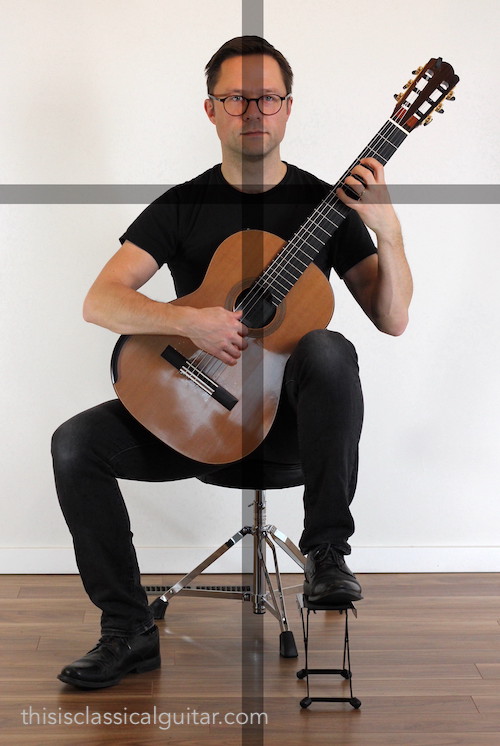
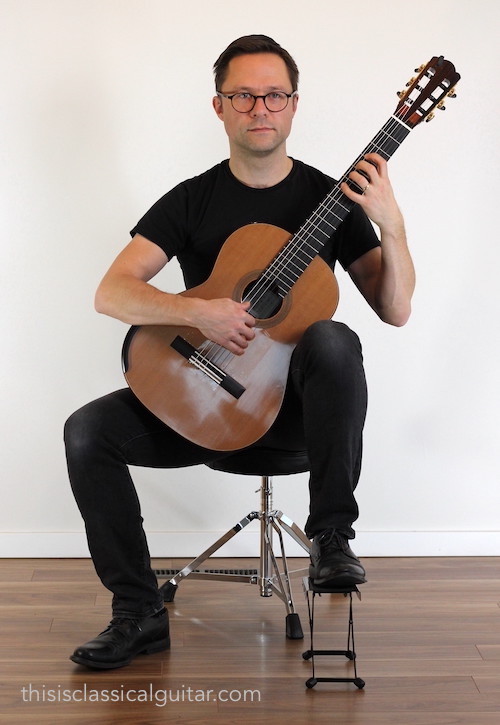
Headstock Level, Angel, Contact Points
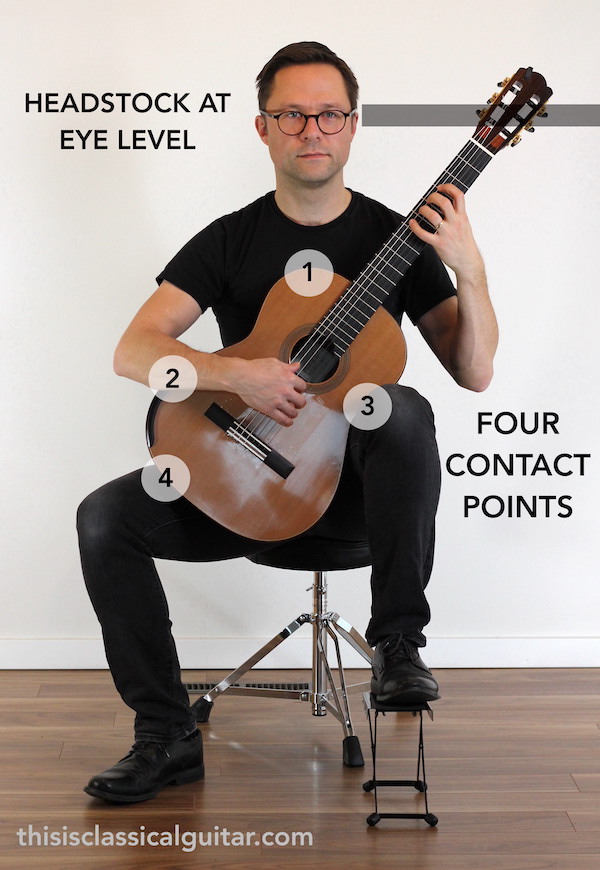
Instructions for the Classical Guitar Position
Headstock Position – The headstock should be around eye level or above. There are many variables in this so it’s all approximate and depends on the player. Modern players and those with guitar supports sometimes have it above eye level.
Guitar Angle – The guitar should be at a 45 degree angle or steeper. Again, there are many variables here and many modern players hold the guitar at a steeper angle which generally brings the headstock closer to your head.
The guitar contacts the body at the following points – 1. Very lightly on the chest. 2. On the right forearm in front on the elbow. 3. On the right thigh (if using a guitar support the support contacts). 4. On the left thigh.
Main Tips
- Sit up straight with your head and spine in alignment. Do not lean to one side or the other.
- Sit on the forward edge of the chair.
- The guitar/guitar neck is at a 45 degree angle or steeper.
- The headstock of the guitar should be approximately at eye level. Experiment with the height of the footstool or support so the headstock is around eye level or higher.
- The left foot is raised with the footstool, the right foot is on the ground. With a guitar support both feet will be flat on the ground.
- Align your centre of gravity by keeping your head, neck, and spine aligned.
- Relax and align your shoulders. Carefully check that one shoulder isn’t raised more than the other.
Position with the ErgoPlay Guitar Support
The picture below shows the classical guitar position while using an ErgoPlay Troster Guitar Support. All the same tips apply except both feet are flat on the ground. You can see my reviews of guitar supports here.
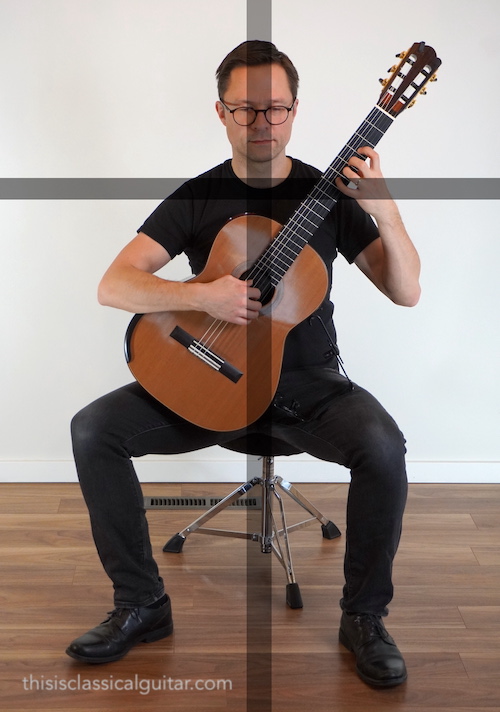
Position with the GuitarLift Support
The picture below shows the classical guitar position while using the GuitarLift Guitar Support.
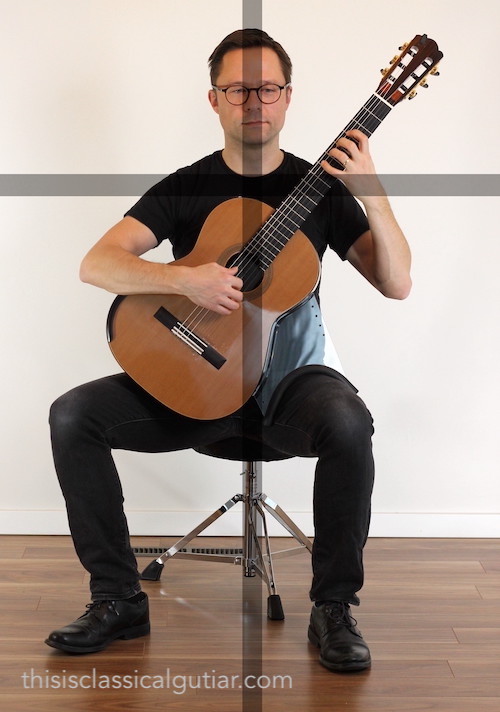
Position with the Gitano Support
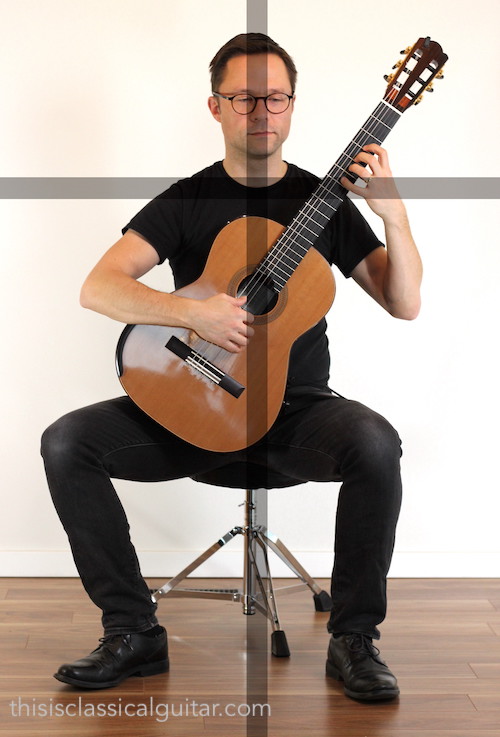
How to look at your left hand
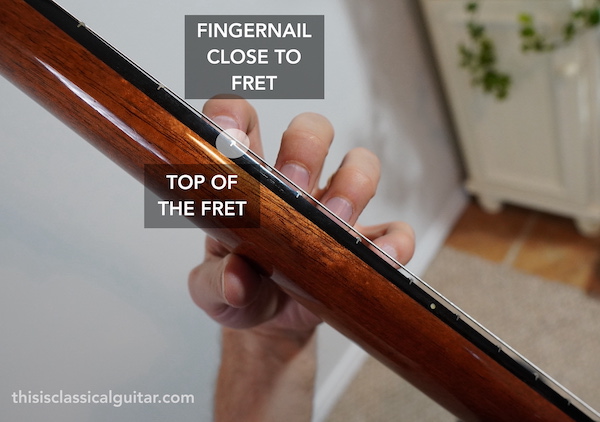
The above picture is from the player’s perspective. So, this is how the left hand should look from your eyes when holding the guitar. Many beginners have trouble maintaining alignment because they want to look at the entire fretboard and their left hand. Instead of leaning the guitar back to see the frets or contorting your body, you can tell where your left hand fingers are based on the top of the frets and your fingernails. You’ll learn to trust your left hand in regards to which string you are one but this is enough of a view to see what fret you are playing.
How it affects your technique
You can see my full post on this at my lesson: 6 Common Technique Problems Solved with a Better Guitar Position
Q&A Follow-up Questions
Q&A Lesson: Classical Guitar Position Follow-up. Thanks to all my supporters who submitted questions. You can visit my Support Page if you enjoy these and want to help out. Here’s the YouTube link if you want to watch the video there.

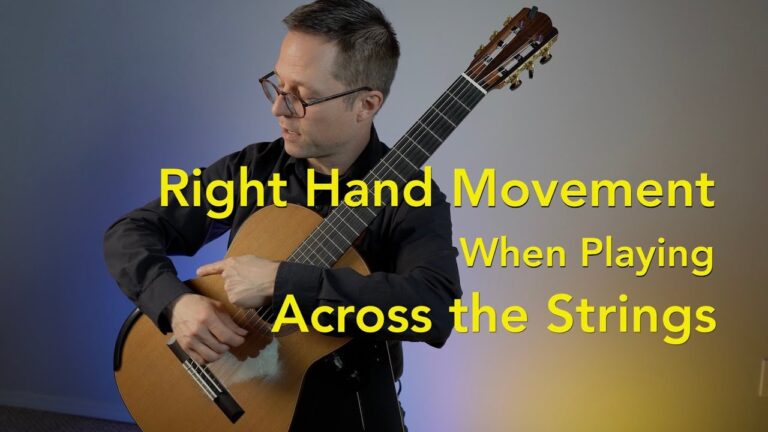
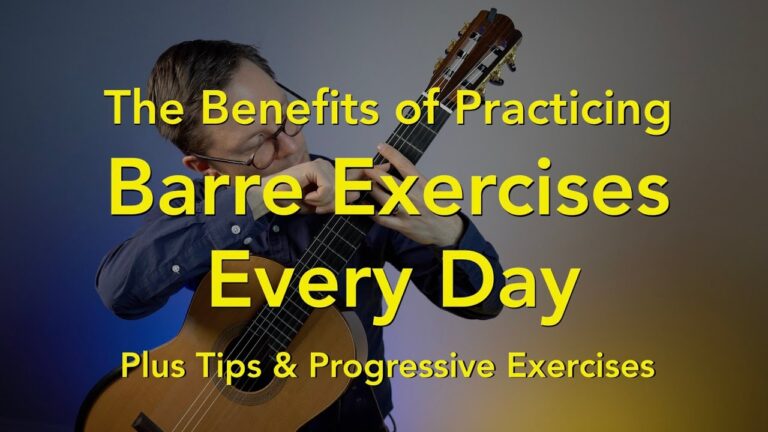
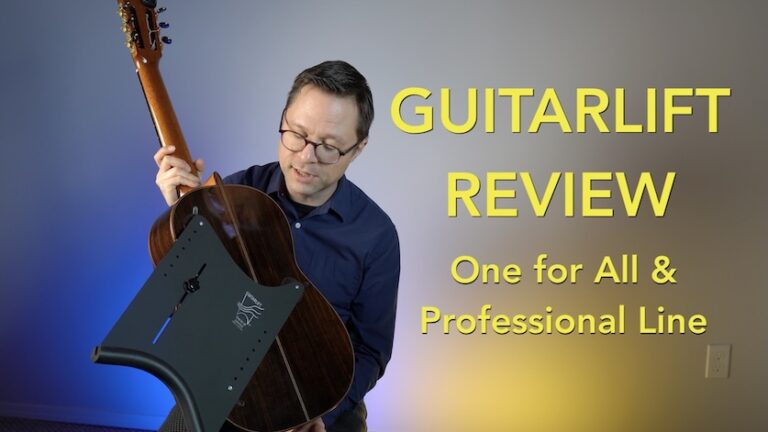
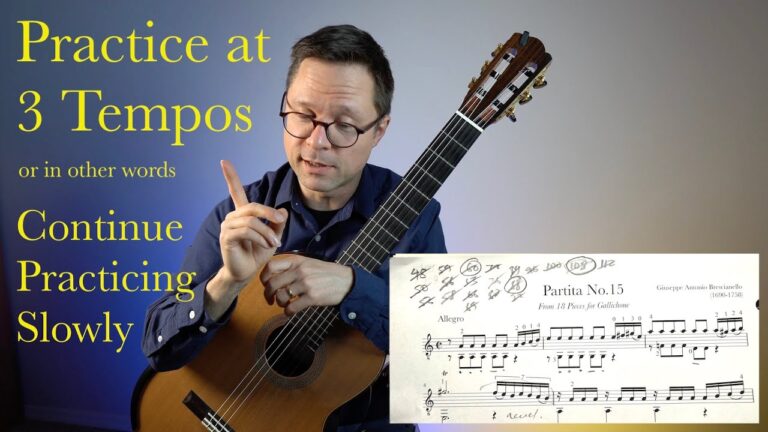
I’ve found your videos on playing position extremely helpful. I’m working my way through the reviews for guitar supports as sometimes extended practice with a footstool leads to a stiff hip joint and other aches. One question: I just cannot get the guitar to stsy vertical. It gradually tilts back towards my body intil it settles in a stable position. I can’t figure out why, or even if I’ve always played this way or it’s something new. I used to play a lot, then there was a gap of some years and I’ve recently picked it up again. Many thanks.
Hi, what part of the guitar is tilting back toward your body? Is it the upper bout coming in toward your chest while pushing the lower bout (near your legs) further away from your hips? Or are you talking about the neck angle?
Dear sir
I have enjoy your beginning lesson on classical guitar. My goal is to use the Howard Morgen finger style guitar method of popular and jazz guitar along with your methods. Thank you for your service maybe I can achieve the goal to play in the nursing homes. Look forward to learning from you.
Thank you and God bless
Dyron Manning
Another solution to this ergonomic (and painful) problem is to re-design the guitar itself.
A reverse construction, such as the Lenvers guitar enable to play both feet on the ground without any support, making it possible to move while playing, and with a much easier access to the higher notes.
You may take a look at https://www.youtube.com/watch?v=OLpqOkxMdkg&t=1s
Or on my site : https://francois-m.jimdofree.com/english/the-lenvers-guitar/
Where does the suggestion for the headstock at eye level come from? I am in between being able to have the stock at eye level and being able to gently bring my left arm up from a resting position to grabbing the fretboard (as you suggest). The stock at eye level seems to require me to keep my left arm in a more lifted position, especially in position 1 (feels like quite a left arm reach too!). Note that I am quite tall at 6’3″. My proportions must be off as you would think with my long arms I would easily be able to reach to eye level or anywhere else for that matter! In what I find as a comfortable position, the head or nut of the guitar is possibly below my chin or even at shoulder level. Is this a stylistic choice? Thanks!
What you said regarding your position all seems fine. My lessons are only a general guideline, everyone is different. One thing to do is to watch lots of pro videos (such as the ones on my site) and when you see a player that has a body type similar to yours to observe them and take note of how they are positioning. You’ll also find that as you advance and play more difficult pieces and exercises that you’ll need to reevaluate your position with small adjustments. Students sometimes adjust their hands and forget to reexamine their whole sitting position so just keep it in mind.
Hi Bradford: I noticed that the guitar support in the picture with Sophia is attached to the upper bout whereas you attach the Gitano and similar supports to the lower bout. Attaching to the upper bout positions the guitar better fo me (eg, headstock at eye level, etc.), but I do not want to go down a bad path. What do you recommend? Thanks.
It depends on the specific support. You’ll notice that the position of the guitar to the body is very similar in all cases. Check out my guitar support page here: https://www.thisisclassicalguitar.com/ergonomic-guitar-rests-support-ergoplay/
I just started and I notice the left side of my neck hurts after a practice session, mostly because I’m looking at my left hand and where I press the strings on the fret board. Would that pain subside over time, or should I maybe turn my torso to the left a bit, so that my neck does not strain so much?
Try to use more of your peripheral vision to see your left hand. Also, notice how you can see the top of the frets which is enough to gauge what fret you are at (as opposed to stringing over to see the actual whole fingerboard). Also try to only look when needed so you have on and off movements.
Should the right forearm rest all of its weight balanced on the front edge of the guitar (assuming your shoulders are not hunched foreward)? Or should some muscle(s) be flexing, to partially relieve the weight of the forearm so that it feels “lighter” on the guitar?
In general, let the arm rest fully on the guitar with gravity. Consider this the ‘rule’ but, that said, you might come in and out of some functional-tension that relieves the weight depending on what you are doing.
I notice that there is quite a difference between the position of the guitar with the female where the tip I f the shoulder is at about the third fret and wuite a lot shorter reach tobthe first position compared to Brad who seems to require more of a reach to the first position.
We are both playing the normal sized 650mm scale length guitar and yet we are different heights and sizes. Small differences will occur. My biggest piece of advice is to watch the pro videos I post every week so you get “a feel” for how the instrument is generally held.
Beginners should start with the top (face of the guitar) straight up and down, that is, not angled. Some small tilt inward toward to the chest is okay but not too much.
I would like to ad that it would be nice to have a profile view on both sides for a good classical guitar posture. Some people play with the head of the guitar almost behind they shoulder, other like Carlevaro suggested that the guitar should rather point forward. Thanks.
It should definitely not be behind the shoulder, the hand can’t really reach back that far…
Thank you Bradford.
Ideal would be a chair fitted with adjustable soft pads where you could place the guitar in it`s playing position and stand back and admire it . So can the long term experts define where the pads should touch the guitar ? I am a sub 5 year player which means I am still thinking it through .
This message follows a search for guitar chairs to reveal bar stools, rocking chairs with an arm sawn off and chairs with grooves to hold a guitar still when not being played .They are “Not Playing a guitar stools “. The rocking chair one armed chair was to support the left arm when fretting the notes.(!!!!!!!) Naughty This is where we came in folks .By the way it cost a modest $3,700 . Cheap at twice the price .
Humour here is not directed at any person . Put it like this i,f I made a machine to fly but did not make any wings could I seriously call it a flying machine ?
An objection to a guitar chair that supported a guitar was made because it might be heavy or awkward to take along to a concert. That is not a real objection . We need to make a start before the objections overrule everything . Henry Ford`s saying with each new machine was “Let`s crank it up and see why it won`t work . ” Make it and try it first . That`s how evolution works .
Thanks. Excellent!
This is very helpful
I am wondering about the angle of the guitar to the body as seen from above. Should it be flat against the body or leaning in or out?
I find when I have the bout right up against my body my right hand feels very relaxed but this tends to push the neck more forward and then the left hand has difficulty stretching across the frets. I was looking at thos because my right forearm has been hurting while I play. I thought I’d found the solution but it just eems to moving the tension /pain between alternate arms.
I have a video coming out for this post and will hopefully answer your question. Should be up by Sunday.
I would like to hear a physiotherapist talk about sitting on the front edge of a chair as in the photos. I think that is a big mistake. If you played a violin in an orchestra you could move around a bit to relieve pressure on the ischial bones but the guitar position demands that you sit still all the time . Do you advise the front edge because the guitar will touch the chair between the legs ?
Yes, it has to do with the size of the instrument and how low the lower bout goes between the legs. Using a smaller instrument with a guitar support device could allow sitting fully on the chair but otherwise not sure what can be done.
Hello, thanks for the tutorial. I wonder if you wouldn’t agree that in shots of the female player, the angle of the neck is too steep? I mean, not Galbraith steep, but with such a steep angel, the right wrist no longer curves into position under the effect of gravity, resulting in less direct relationship between RH digits and the strings. I would suggest that the support is maladjusted, lifting upper bout too high–thoughts?
A lot of young pros are playing with even steeper angles. My only issue with steep angles is if bothers my left hand shoulder, otherwise I’m all for it for the ease of reach…
What’s wrong with a strap? Seems to be just a fashion thing – everybody else except classical guitarists use them?
I think the strap supports and makes it easier for the guitarist to hold the guitar, especially for a long time standing or sitting.
Thank you Bradford. I really appreciate your thoughtful and thorough response. It’s a pleasure to receive your sound advice. Please keep up the good work
What are your thoughts on using the right thigh? It’s more comfortable for some people. Are there any particular reasons/arguments in favour of using the left thigh? For many years I used a footstool and put my guitar on my left. After about 20 years I changed to my right, and use a support. It suits me and I find quite a few students, given the choice, tend to prefer the right. Flamenco players are an interesting example of alternative, but clearly very effective ways of holding the guitar. Paco de Lucia uses his right thigh and crosses the leg as well. It certainly works for him.
Howard, it’s really not a question of which leg or how you position the guitar. I think the really important aspect is how healthy and ergonomic one’s position is. When I think of teaching students I’m mainly looking into their future to see if tension or even injury could result. Therefore, as in the case with good flamenco players, where exactly the guitar is located seems less important to looking closely at the body.
That said, I often find that students twist their spine when the guitar is located on the right. That is not always true, as you stated. Therefore, I recommend that a very vertical guitar angle be used to incorporate the left leg. Overall I simple have more success this way. I’m also going after a specific style right. I use certain players as models for students. The players I use may not be the same as others use.
One other possible problem is that the modern guitar evolved from much smaller instruments. When we increased the size of the instrument I don’t think it kept it’s ergonomic principles. We increased the size but kept the same general shape therefore making it uncomfortable for some people. In particular I find that the right arm has to extend outward. Also, with modern instruments some women find that the guitar is too close to their chest which is in part due to the modern size of the instrument. I think ergonomic supports are a reaction to this, as are the increased used of smaller scale instruments.
Bradford,
Thanks for posting this. Excellent work.
I would add that when using a footstool, ensure that the footstool is positioned far enough outside of the hip that the leg falls inward toward the center of gravity. This relieves the inner thigh, and brain, of the extra work of holding the leg in place.
Strictly my observation, but I find it works quite well and very naturally.
Good point Rick! Experimentation is key to the process. One must understand why and what we do with our bodies and then know the reason for doing one thing or another.